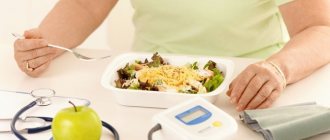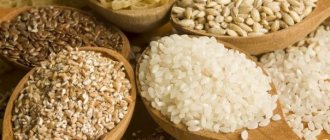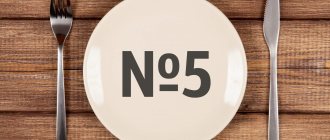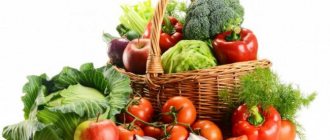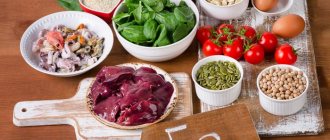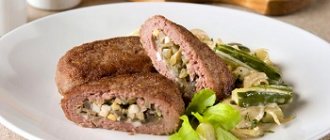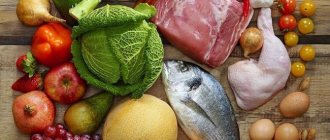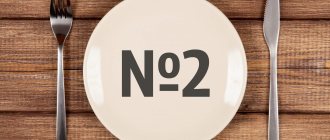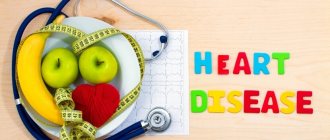Treatment tables (diets) according to Pevzner - this is a diet system created by Professor M.I. Pevzner, one of the founders of dietetics and gastroenterology in the USSR. The system is widely used in the complex treatment of diseases of patients in hospitals and sanatoriums. The tables are also of a recommendatory nature for patients when they are outside medical institutions.
The Pevzner diet system includes 15 treatment tables corresponding to certain groups of diseases. Some of the tables are divided into categories with letter designations. Categories of therapeutic diets correspond to the stage or period of the pathological process: exacerbation (height) of the disease → fading exacerbation → recovery.
Indications for the appointment of treatment tables:
Diet No. 1, 1a, 1b – stomach and duodenal ulcers; Diet No. 2 – atrophic gastritis, colitis; Diet No. 3 – constipation; Diet No. 4, 4a, 4b, 4c – intestinal diseases with diarrhea; Diet No. 5, 5a – diseases of the biliary tract and liver; Diet No. 6 – urolithiasis, gout; Diet No. 7, 7a, 7b, 7c, 7d – chronic and acute nephritis, chronic renal failure; Diet No. 8 – obesity; Diet No. 9 – diabetes mellitus; Diet No. 10 – diseases of the cardiovascular system; Diet No. 11 – tuberculosis; Diet No. 12 – diseases of the nervous system; Diet No. 13 – acute infectious diseases; Diet No. 14 – kidney disease with the passage of phosphate stones; Diet No. 15 – diseases that do not require special diets.
Table No. 0
Recommendations for product types
Indications:
- undergone surgical interventions on the gastrointestinal tract
- rehabilitation of patients in the intensive care unit
- cerebrovascular accident
- after traumatic brain injury
- for patients with infectious diseases who are in serious condition.
Diet: 5–8 times a day
Duration of appointment: as needed
Nutritional features: this diet is designed to restore the patient’s vitality, replenish nutrients and increase the overall resistance of the body. The diet is very strict.
Quitting the diet
When the diet is over, another important moment comes - the exit period, which requires no less pronounced efforts than the nutrition system itself. Judging by the reviews, after 7 or 14 days of the diet, it is very difficult to follow any other rules and restrictions. At the end of the course, the body’s metabolism is very slow, and the body is in strict energy saving mode. If you return to your usual diet, the body will quickly gain reserves, because... is in a state of energy and nutritional deficiency. That is why portions need to be increased gradually, from week to week.
It will be more effective if the portions are increased by adding leafy greens and fresh vegetables. Small portions of porridge or meat are psychologically easier to bear if served on a plate filled with fresh cucumbers, herbs, carrot slices, pepper rings, etc. Try to replace unhealthy foods with healthy ones: instead of sweets - prunes, instead of spaghetti and pasta - fresh vegetables as a side dish, dairy products - low-fat. When leaving the diet, to maximize the results, it is important to completely give up fried foods, sweets and fatty foods.
Table No. 1
Recommendations for product types
Indications:
- peptic ulcer of the stomach and duodenum in the acute stage and unstable remission;
- acute gastritis;
- chronic gastritis with normal and high acidity in the stage of mild exacerbation;
- gastroesophageal reflux disease.
Diet: 4–5 times a day
Duration of appointment: at least 2–3 months
Nutrition Features:
Dishes are served in a semi-liquid or jelly-like form, warm; meat dishes and potatoes are cooked without frying. Limit the content of table salt.
Table No. 1a
Modification of the main table with a strict gentle diet that protects the gastric mucosa. This diet involves eating food in liquid, mushy and jelly-like form.
Indications:
- stomach and duodenal ulcers (severe exacerbation);
- exacerbation of chronic gastritis with severe pain;
- condition after gastrointestinal bleeding (after a strict gentle diet).
Diet: 5–6 times a day
Appointment period: several days
Recommended: milk, mucous cereal milk soups with butter; liquid, pureed, milk porridges; soft-boiled eggs or steam omelettes; steam soufflés from lean varieties of fish and meat; unsalted butter or olive oil, cream; berry, fruit (non-acidic) and milk jelly, carrot, fruit juices, rosehip decoction, weak tea with milk.
Salt is limited to 5–8 g, liquid - to 1.5 liters. Additionally, vitamins A, C, and group B are prescribed.
Table No. 1b
Prescribed to ensure a smooth transition from a strict gentle diet to a basic diet.
Indications:
- subacute phase of peptic ulcer and exacerbation of gastritis.
Diet: 4–5 times a day
Appointment period: several days
Nutritional features and products:
The food is prepared in a puree form, 75–100 g of crackers from premium white bread, meat and fish in the form of cutlets, quenelles, and meatballs are added. More often they give pureed milk porridges. Milk and cereal soups.
What is nutritional therapy?
Therapeutic nutrition is a diet designed in such a way that a complex of foods consumed over a long period of time strengthens the effect of the main treatment and reduces the likelihood of relapses and exacerbations in the chronic course of the disease. The so-called diet therapy takes into account all the nuances of the course of the disease, its clinical manifestations, dynamics, and non-compliance with this in some diseases simply does not allow achieving the desired result in treatment. The effect of diet therapy on the patient’s body is determined by:
- qualitative and quantitative composition of food (proteins, fats, carbohydrates, vitamins, minerals, trace elements, etc.) and its calorie content;
- physical properties - volume, temperature, consistency;
- diet - hours of intake, distribution of food during the day, frequency of meals;
- medicinal properties of some products.
Therapeutic nutrition is based on the principles of so-called sparing of the body, of which there are three types:
- mechanical sparing is mainly two processes in relation to products, their grinding and heat treatment, as a result of which a consistency that is as easy to digest as possible is achieved; helps ease and normalize gastrointestinal function;
- chemical sparing - exclusion from the diet of sour, spicy, salty, fried foods, thereby avoiding the secretory activity of the gastrointestinal tract and the stimulating effect on the body as a whole;
- thermal sparing - exclusion from the diet of strong thermal irritants, namely very cold (less than 15°C) or hot (more than 60°C) food; This eliminates the sap effect of hot water, which weakens gastric motility, or the effect of cold food, which reduces motility and juice secretion.
Medical nutrition certainly contains a strict regime and frequency of portion consumption. For example, increasing the number of meals up to five times means reducing the time between meals to 3-4 hours. Some diets take into account not only the meal schedule, but also the calorie content of each serving. The therapeutic nutrition regimen is based on the following features:
- extremely rarely, almost never, a complete diet that satisfies the patient’s appetite and taste does not meet the requirements of therapeutic measures in the treatment of chronic conditions;
- the amount of calories consumed should correspond to gender, age, nature of the activity performed and general health;
- the diet should ensure that the body receives the full amount of vitamins, minerals and water;
- any diet must provide the body with a sufficient amount of protein, the lower limit of which is usually calculated as 1 gram of protein per 1 kg of human weight;
- the diet of a sick person, no less than a healthy one, requires the supply of plant fiber and leafy vegetables, the processing of which can promote faster absorption, but the component itself must remain unchanged;
- raw vegetables, fruits and herbs should be present in any type of dietary food, even in minimal quantities; under the most stringent restrictions, freshly squeezed juices diluted with water can be an alternative;
- meals within the framework of therapeutic nutrition should be distributed throughout the day, and sometimes even 24 hours, dinner should occur 2-3 hours before bedtime; The diet should be compared with the time of rest, vigorous activity and therapeutic procedures;
- The transition from one mode to another should be carried out gradually.
Table No. 3
Recommendations for product types
Indications:
- chronic diseases and functional bowel disorders accompanied by constipation.
Diet: 4–5 times a day
Duration of appointment: unlimited
Nutrition Features:
Food is prepared mostly unchopped, boiled in water or steamed, or baked. Vegetables and fruits are consumed raw or boiled. The diet includes cold first and sweet dishes and drinks.
Doctors' diet for 7 days and 14 days, menu (Meal schedule)
The shortest medical diet lasts 7 days. Below will be presented a seven-day fasting diet, the recipe was developed by doctors.
It is recommended to study the menu in advance in order to prepare all the necessary products and prepare yourself mentally for a week of limited nutrition.
The first day
It is a cleansing fast. On this day you can only drink water, the permitted volume is 1.5 liters.
Second day
A little easier than the first one. On this day you can drink skim milk (4 glasses). You are allowed to eat 1 apple at 7 pm.
Day three
Again a fasting day, on which you can only drink water (volume 1.5 liters). This concludes the most difficult part of the diet.
Day four
Cabbage salad with the addition of greens and carrots (volume for the whole day - 1 liter). The salad can be dressed with olive oil.
Day five
The menu for this day duplicates the second day of the diet, on which you can drink only 4 glasses of skim milk per day.
Day six
| Breakfast |
|
| Dinner |
|
| Dinner |
|
Day seven
| Breakfast |
|
| Dinner |
|
| Dinner |
|
Doctors' diet for 14 days
The diet menu completely duplicates the 7-day diet option. The medical diet for 2 weeks is more difficult to tolerate and is recommended for those who have already tried the 7-day diet and tolerated it well. Initially, going straight to the 14-day course without preparation is not recommended. The reviews are very different: in terms of effectiveness - positive, in terms of tolerability - negative.
Table No. 4
Recommendations for product types
Indications:
- acute and exacerbation of chronic intestinal diseases, accompanied by diarrhea (diarrhea)
Diet: 5 times a day
Appointment period: several days
Nutritional Features:
Mechanical, chemical and thermal irritants of the gastrointestinal tract are sharply limited. Products and dishes that stimulate the secretion of the digestive organs, the processes of fermentation and putrefaction in the intestines are excluded. Dishes are liquid, semi-liquid, pureed, boiled in water or steamed. Very hot and cold dishes are excluded.
Table No. 4a
Indications:
- colitis with a predominance of fermentation processes.
Diet: 5 times a day
Appointment period: several days
The composition is the same as in diet No. 4, but carbohydrate-rich foods (porridge, bread, sugar) are sharply limited and the protein content is increased due to meat dishes and pureed cottage cheese.
Table No. 4b
Indications:
- chronic colitis in the attenuation stage of the disease.
Diet: 4–6 times a day
Duration of appointment: from 1–2 months to several years
Diet features:
In contrast to the main diet, snacks are allowed (mild cheese, doctor's sausage, pate, veal, soaked herring, jellied meat, jellied tongue) and sauces (meat, vegetable and fish weak broth with dill, parsley leaves, milk bechamel sauce with the addition of a small amount of sour cream, fruit sauces, cinnamon can be used).
All dishes are boiled or steamed, pureed, slimy, and served warm.
Table No. 4b
Indications:
- acute intestinal diseases during the recovery period as a transition to a balanced diet;
- chronic intestinal diseases during the period of exacerbation;
- chronic intestinal diseases without exacerbation with concomitant lesions of other digestive organs.
Diet: 5 times a day
Duration of appointment: several months
Nutrition Features:
This diet is prescribed to provide adequate nutrition in case of intestinal dysfunction to restore the function of other digestive organs. The diet is physiologically complete with limited salt intake and a slight increase in the amount of protein foods. It excludes foods that enhance the processes of putrefaction and fermentation in the intestines, activates its secretion, as well as the secretion of the pancreas and stomach. You need to prepare dishes by steaming, crushed, or baking or boiling.
Diets for various diseases
Many people in Russia (not abroad) are familiar with the M.I. Pevzner diet, recommended for various diseases. They have their own numbers, for example, diet No. 5 for liver diseases or table No. 10 for hypertension and heart disease. In modern dietetics, the Pevzner diet system is considered outdated. In his book “Rational and Medical Nutrition” in 1930, M. I. Pevzner proposed a group nutrition scheme that included 21 dietary tables (actually 15, some of which are divided into a, b, c).
Of course, Pevzner instilled in society the idea that a therapeutic diet is necessary for healing, for which we will always be grateful to him. But his diets were developed for hospitals and sanatoriums of the Soviet Union - both for the purpose of improving health and for the purpose of saving money. Pevzner wrote: “Individual therapeutic nutrition is an expensive pleasure, inaccessible to most people in a sanatorium or hospital. And to feed thousands and millions of people at that time, it was possible to offer only “group” meals, focused “on the disease, and not on a specific patient.”
Today the opposite principle prevails: we treat not a disease, but a patient who may have not one, but several health problems, and sometimes patients come to us with the question of what they should ultimately eat, because recommendations, for example, for constipation and diabetes coupled with coronary heart disease are mutually exclusive, leaving no permitted products. The answer lies not in reading diets verbatim, but in following the principles of therapeutic nutrition. In general, Pevzner tables can be represented as follows:
Table No. 0 After operations - baby food, we minimize mechanical irritation of the mucous membranes, facilitate the absorption of nutrients with a gradual expansion of the diet over the course of a month.
Table No. 1 Stomach diseases with high acidity - day-old bread, lean meat and fish, low-fat dairy products, cereals - rice, buckwheat, semolina are recommended, you can steam omelettes, boiled or baked vegetables, sweet fruits, fermented milk tan, ayran, unsweetened yogurt . Any spicy, highly salty or sour foods, fried foods, canned food and marinades are prohibited.
Table No. 2 Gastritis with low acidity - everything is possible except cabbage, legumes, buns, very fatty foods (avoid bloating).
Table No. 3 Constipation - yesterday's bread, fermented milk products, fresh vegetables and fruits are useful, if the stomach does not hurt, (or heat-treated - for intestinal spasms, since coarse fiber stimulates peristalsis, which can increase pain), dried fruits and compotes from them. Do not eat sour, fatty, spicy, hard-boiled eggs, or strong tea.
Table No. 4 Diarrhea - you can have soups, crackers, cereals - semolina, oatmeal, rice, buckwheat. Food should be free of spices, marinades, coarse fiber, fruits, vegetables, and legumes. Fermented milk products include yoghurt, cottage cheese, and cheese.
Table No. 5 Cholecystitis, pancreatitis - all food and drink should be warm to avoid spasms of the biliary tract. Avoid fatty, fried, smoked, cruciferous vegetables (cabbage, radishes, radishes, turnips), garlic. In case of bile stagnation, a mandatory meal before bed (to empty the gallbladder before the night peak of bile production). In case of acute inflammation of the pancreas - “cold, hunger and rest”, minimize food intake.
Table No. 6 Urolithiasis (urate in the urine) - alkalizing foods are good: dairy, vegetables. You can't eat legumes, smoked meats, or mushrooms. Limit meat, fish, fats, spices, cruciferous vegetables. When kidney stones and diarrhea are combined, vegetables must be heat-treated and milk replaced with the fermented milk product that is best tolerated (cottage cheese, cottage cheese).
Table No. 7 Nephritis - a milk-vegetable diet without fatty, spicy foods, and cruciferous vegetables are again excluded (the kidneys do not like white cabbage and meat, because they contain a lot of nitrogen, which must be actively removed).
Table No. 8 Obesity - counting calories! There are many diets, but they are all ineffective, because the main principle of losing weight is to consume less than you spend. All high-calorie foods are removed - fatty foods, simple carbohydrates (bread, rice, semolina) and sweets, incl. juices, limited to cheese. It is recommended to eat more vegetables to cleanse the intestines.
Table No. 9 Diabetes mellitus - all diabetics already know from the endocrinologist what they can and cannot do, the diet is explained to them at the time of diagnosis, because it is the most important aspect of treatment. White bread, rice, semolina are strictly prohibited (hard varieties of pasta and semolina are limited, red and brown rice are allowed) and, of course, everything sweet and fatty. If you combine diabetes with heart disease, you can still eat fish, but preferably not the fattest one. Beets, which are not accepted by everyone because of their sweetness, are introduced into the diet for constipation, as are dried fruits (prunes, figs, dried apricots) until stool normalization, but under strict glucose control.
Table No. 10 Heart and blood vessels - regarding the diet that prevents heart attacks and strokes, cardiologists and neurologists agreed in a common opinion: fatty sea fish and at least 400 g of vegetables per day are beneficial, but it is better to limit baked goods and animal fats. These recommendations contradict nutrition for diseases of the biliary tract, where fatty fish is not allowed, well, here you either take omega-3 in capsules (instead of fish), or “cover” the main dishes with enzymes (Creon) or choleretic drugs - depending on the clinical situation.
Table No. 11 Tuberculosis, exhaustion - to restore the body you need a lot of calories, meat is especially necessary, you can use spices and any methods of processing food. If exhaustion develops against the background of pancreatitis, the amount of food should be moderate, very frequent, but in small portions and always with enzyme preparations. If you are exhausted due to problems with blood vessels (for example, after a stroke), the diet should be varied, rich, but without animal fats.
Table No. 12 Neuroses - Pevzner considers only increased activity of the nervous system, therefore excludes “provocateurs” - smoked spices, pungency and sauces, sweets, however, for depressive disorders and general weakness, we recommend including “invigorating” foods in the diet - garlic, seasonings, ginger, ginseng, as well as dark chocolate, which has a proven antidepressant effect.
Table No. 13 Acute infectious diseases - a diet without “generally aggressive” foods, everything with the prefix “not too” (not too fatty, spicy, salty, spicy...)
Table No. 14 Urolithiasis (phosphates in the urine) - sour compotes, mushrooms, no pungent foods are good, limit vegetables, dairy products. This table, by the way, is directly opposite to the diet for gastritis - it means that we first reduce the acidity (for example, with pantoprazole), against the background of which we cure the kidneys, and then we adhere to a neutral diet (not acidic, not alkaline food).
Table No. 15 Almost healthy - bran, rye or oat bread, lean meat, offal, fish, seafood, all types of vegetables, herbs are recommended; sweet and sour varieties of fruits, berries, porridge, any pasta, any dairy products, vegetable and butter, natural homemade desserts, nuts, seeds. And chips, soda, smoked meats and sauces (mustard, ketchup, mayonnaise, Tabasco) are not good for anyone. This doesn't mean you can't, it means don't get carried away.
There are general trends in healthy eating in case of any illness and in their absence: meals should be varied, divided (4-5 times a day), include fruits and vegetables, meat and fish, bread and cereals. Oils, fats, and smoked spices are limited in almost any illness; it is better not to consume sauces and soda even if healthy, so that they remain so.
There can be no recommendations regarding each specific product, because, frankly, the effect on the body from ripe and unripe strawberries will vary more than from strawberries and tomatoes.
Not only products are important, but also their quality: for fruits, berries, vegetables - their ripeness, for meat and fish - their fat content, cooking methods, amount of seasonings. With a complete diet, no multivitamins or dietary supplements are needed. (Read the article about multivitamins >>)
So what should you put in your trolley at the supermarket?
1. Vegetables
- Potatoes, sweet potatoes, cauliflower, kohlrabi, broccoli, zucchini, zucchini, pumpkin, beets, carrots, onions, garlic, parsley and celery roots, fennel, parsnips, artichoke, rhubarb, asparagus - you can and should, but it is better to eat them thermally processed , especially for any digestive and stool disorders;
- white cabbage, radishes, radishes, turnips - not worth it if you have diseases of the kidneys or digestive organs, especially if you suffer from bloating;
- tomato, eggplant, pepper - not during exacerbations of gastrointestinal diseases, they can irritate damaged mucous membranes, it is better to eat without peel;
- legumes (green beans and legumes, lentils, peas, mung bean) - a source of protein for those who limit themselves to meat, it is important not to overuse it to avoid flatulence;
- Avocado is an excellent healthy vegetable, but it is fatty and is not recommended for diseases of the biliary tract.
2. Fruit
- sour apples, oranges, lime, lemon, kiwi, pineapple, exotic fruits - it is better not to take in case of exacerbation of gastritis or diarrhea, colitis;
- apricots, plums, dried fruits - perfectly cleanse the intestines
- bananas, sweet apples and pears, watermelon - if you don’t have diabetes, then live vitamins will be useful to everyone
- peaches, pomelo, mangoes, melons - if ripe, they are always good (Avicenna wrote about melons as a cure for many ailments);
- sour berries (fruit drinks) for urate kidney stones (not to be confused with phosphate stones!), not for acid gastritis and constipation.
Hand on heart, the effect on the body from ripe and unripe strawberries will vary more than from strawberries and tomatoes.
Not only products are important, but their quality: for fruits, berries, vegetables - their ripeness, for meat and fish - their fat content and cooking methods, incl. amount of seasonings 3. Greens
- Cucumber (yes, it is more of a green than a vegetable), leafy salads (Chinese cabbage, iceberg, watercress, arugula, etc.), a stalk of celery - fresh daily for everyone.
- Sorrel, spinach, sauerkraut - excluded in case of high acidity and urolithiasis.
4. Bread is better dried or in the form of toast.
It’s better not yeast, but sourdough. For gastritis and diarrhea, white is recommended; for constipation, rye or with bran; for diabetes and obesity, it is better to avoid it altogether. 5. Cereals, pasta White rice, soft semolina, couscous are the most high-calorie and safe for digestion, but they are not recommended for obesity and diabetes, buckwheat and oatmeal, bulgur and hard semolina are also useful for everyone, but pearl barley and millet It is better to cook cereals, red and brown rice outside of exacerbations of gastritis and colitis. Pasta made from durum wheat, as well as from rice and buckwheat flour, is suitable for everyone, even those who are losing weight.
6. Nuts, seeds Walnuts, hazelnuts, peanuts, pistachios, cashews, sunflower seeds, pumpkin seeds, flax seeds, sesame seeds - 30-50 grams per day (as much as fits in a handful), but limit in case of pathology of the biliary tract, because nuts and seeds are very fatty. Can be used as part of grain bread.
7. Oils
- up to 15 ml per day (1 teaspoon 3 times a day) for cholecystitis, pancreatitis, obesity, diabetes.
- up to 50 ml per day in the absence of the need to limit fat.
8. Fish
- Cod fish (cod, hake, pollock, haddock), flounder, perch, catfish and other sea fish should be a constant part of the diet.
- Herring, mackerel, fatty red fish (large trout, sea bass) - not worth it if you have pancreatitis, bile outflow disorder, no more than 150 mg per serving.
- Fish caviar contains a lot of fat, so it is limited in case of cholecystitis and pancreatitis. As a rule, it is highly salted, so if you have gastritis or stool problems, it is also better not to eat it.
9. Meat
- Chicken, turkey, quail, rabbit - recommended for everyone.
- Beef, lean pork - limited in case of any painful conditions, as “heavy” food, until recovery.
The older a person gets, the less red meat he needs.
Increased consumption of animal meat and liver is required for anemia and calcium deficiency. A fried meat crust is not at all healthy, because the phenols contained in the fried side of the cutlet can cause fatty liver, and eating kebab increases the risk of colorectal cancer. Eggs are good for everyone; they contain essential phospholipids (2 yolks contain more than 11 capsules of Essentiale), which normalize the flow of bile. Albumin (egg white) is allergenic, but very easily digestible. 10. Alcohol 1 serving of alcohol once a day is useful, especially in the evening and after meals - it improves blood circulation and prevents the formation of atherosclerotic plaques. True, this rule applies to those who already drink alcohol, but if you have never drank it, then you still shouldn’t start, because... the negative impact on an unprepared liver will outweigh the possible benefits.
1 serving of alcohol is 100 ml of wine for women and 150 ml for men or 30 ml of 40*drinks for women and 50 ml for men. As you drink more, the benefits do not increase, but the liver suffers. Beer has only a negative and multifaceted effect on the body, so it is better to avoid it altogether.
11. Coffee, tea Coffee is recommended by the World Health Organization in the amount of 3 cups of strong drink per day. It is slightly choleretic, so it is not recommended on an empty stomach (to avoid the reflux of bile into the stomach), only after breakfast. Both tea, especially black, and coffee, both brewed and instant, increase acidity, so if you have gastritis, it is better to avoid them.
12. Fermented milk products In our country, 80% of people cannot tolerate milk (stool disorder or allergies), kefir, yoghurt, fermented baked milk are well tolerated by half of the population, but an uncomfortable reaction to some fermented milk products does not mean the same for others. They contain different types of beneficial bacteria, each has its own dominant bacteria in the intestines, and you need the bacteria from yogurt to “make friends” with your native flora and suit a specific person, so the choice of these products is by trial.
Cheese is very high in calories due to fat and contributes to disruption of the outflow of bile, exacerbation of pancreatitis and constipation with large consumption. It is better to eat low-fat and low-salt cheeses, 50g per day. Cottage cheese is not so fatty, it is easier to tolerate, so it does not have such strict weight restrictions.
13. Harmful effects Mayonnaise and ketchup are strictly prohibited if you have pathology of the digestive system, and when possible, it is better not to overuse it. Everything is good in moderation.
Smoked sausages negatively affect the liver due to the content of phenols in them (like fried meat), and seasonings, which are present in large quantities in their composition, irritate the mucous membrane of the stomach and intestines. It’s better not to take them, but if you really want them, then at least boil them, not smoked.
Butter dough disrupts all known digestive processes and can only be consumed as a tasty treat, not often.
Sugar-based sweets without fat (marshmallows, marmalade, marshmallows) are not prohibited if there is no diabetes or obesity. Chocolates contain confectionery fats, the composition of which can often be scary, so the range of their possible negative effects is wide. But dark chocolate is healthy, and in moderate doses of 15 mg per day is even recommended.
Fruit juices are limited in case of high acidity (especially tomato and orange) and diabetes and obesity, because contain on average 13g of carbohydrates per 100ml of water, the same as 8 tablespoons of sugar per glass of tea. Carbonated drinks always increase acidity and tend to cause heartburn; they are especially strictly prohibited in case of ulcers, pancreatitis and gastroesophageal reflux disease.
The main thing is that food should bring not only benefits, but also joy. Eat deliciously and be healthy!
Table No. 5
Recommendations for product types
Indications:
- chronic hepatitis with a benign and progressive course;
- liver cirrhosis without exacerbation;
- chronic cholecystitis;
- cholelithiasis;
- acute hepatitis and cholecystitis during the recovery period;
- other diseases accompanied by dysfunction of the liver and biliary tract.
Diet: 5 times a day
Duration of appointment: unlimited
Nutrition Features:
Dishes are mostly boiled or baked after pre-cooking. Food is prepared mainly in uncut form. Flour and vegetables for dressing are not fried, but dried.
Table No. 5a
Indications:
- acute hepatitis and cholecystitis;
- exacerbation of chronic hepatitis, cholecystitis, liver cirrhosis.
Diet: 5 times a day
Appointment period: several days
Nutritional features: nutrition is the same as with diet No. 5, but you should eat more protein-containing foods, limit foods containing fats and carbohydrates; dishes that enhance the processes of fermentation and putrefaction in the intestines, strong stimulants of bile secretion and substances that irritate the liver.
Dishes are prepared boiled, pureed, and served warm. Separate baked dishes of meat and fish, pre-boiled, without crust, are allowed.
General rules
The doctors' diet is designed for a certain category of citizens and is not suitable for everyone who wants to lose excess weight .
The nutrition system is designed for people who are preparing for surgical treatment, and who therefore urgently need to get rid of extra pounds. The system assumes full medical support. If there are no indications for using this diet, but if you follow all the rules, you will, of course, be able to lose weight. However, the nutritional system can lead to a slower metabolism, and not a faster metabolism , as many hope. The diet can vary in duration, and the weight can be 10-15 kg. A long course can negatively affect your health. You can avoid the unpleasant consequences of diet by taking multivitamin complexes and minerals.
Only the attending physician can prescribe a diet. If you decide to eat according to this system on your own, it is recommended to consult a doctor and assess the body’s readiness to deal with such stress . You may need to undergo additional testing. 10-15 kg in 2 weeks is considered a very large weight, which can negatively affect the functioning of the organs and systems of the body. Only with strong motivation can one withstand such severe restrictions.
Table No. 7
Recommendations for product types
Indications:
- acute nephritis in the recovery phase;
- chronic nephritis without exacerbation;
- nephropathy of pregnant women and other diseases requiring a salt-free diet.
Diet: 4–5 times a day
Duration of appointment: long
Nutritional features: the diet is complete, practically no different from the diet of a healthy person. Patients are advised not to abuse protein foods (up to 0.8–0.9 g/kg) and somewhat limit salt (7–8 g/day).
Table No. 7a
Indications:
- acute and chronic nephritis in the acute stage;
- terminal chronic renal failure.
Diet: 5 times a day
Appointment period: several days
Nutritional features: modification of the basic diet with the complete exclusion of salt, severe restriction of fluid and protein.
Table No. 7b
Indications:
- recovery period after acute kidney inflammation;
- CRF.
Diet: 5 times a day
Duration of appointment: from several days to several months
Nutritional features: modification of the basic diet with restriction of salt and protein, is transitional from No. 7a to No. 7
Tables No. 7v and No. 7d
Prescribed to persons with severe nephrotic syndrome and those on hemodialysis, respectively.
They represent a modification of the basic diet with increased protein content.
Advantages and disadvantages
| pros | Minuses |
|
|
Table No. 8
Recommendations for product types
Indications:
- obesity as a primary disease or concomitant with other diseases that do not require special diets.
Diet: 5–6 times a day
Duration of appointment: long
Nutrition Features:
Reducing the caloric content of the diet due to carbohydrates, especially easily digestible ones. and, to a lesser extent, fats (mainly animal) with normal protein content. Restriction of free fluid, sodium chloride and appetite-stimulating foods and dishes. Increased dietary fiber content. Dishes are prepared boiled, stewed, baked. Use sugar substitutes for sweet foods and drinks.
Doctors' diet: reviews and results
The medical diet is gaining popularity today. On thematic forums you can find menus and results, but they often present embellished results. The presented diet is very complex and requires complete willpower. It will be better if you find like-minded people who can support you every day in difficult times, at the risk of failure. When evaluating reliable reviews, we can conclude that a medical diet for weight loss allows you to get rid of 5-7 kg in 7 days and 14 kg in 14 days.
Photos of results
Reviews of the medical diet for 7 days are mostly positive. On average, 1 kg is lost per day. The number of kilograms lost largely depends on the initial weight: the higher it is, the greater the weight. The diet is not recommended for those who want to get rid of 3-5 kilograms or less. For these cases, there are softer, balanced diets that are safe for health. The effectiveness of the medical diet is proven by the results with photos.
Table No. 9
Recommendations for product types
Indications:
- mild to moderate diabetes mellitus;
- establishing tolerance to carbohydrates;
- selection of doses of insulin or other drugs.
Diet: 5 times a day
Duration of appointment: sometimes for life
Dietary features: dishes are served boiled, baked, steamed, fried - to a limited extent.
Recommendations from experts
In pursuit of a perfect body, you should not neglect consultation. The selection of a weight loss program with a detailed description of the menu, calorie content, and nutrient ratios must be entrusted to an experienced specialist. He will be able to take into account all the individual characteristics of the body of a person who wants to lose weight, the presence of diseases and contraindications.
A complete medical examination will help obtain health data that will help make a decisive choice in favor of one or another technique.
Table No. 11
Recommendations for product types
Indications:
- tuberculosis of the lungs, bones, lymph nodes, joints with a mild exacerbation or its attenuation, with low body weight;
- exhaustion after infectious diseases, surgery, injuries.
Diet: 4–5 times a day
Duration of appointment: 1–2 months or more
Nutrition Features:
The diet has a high energy value with a high content of proteins, minerals and vitamins.
Indications
The medical diet has 2 main purposes:
- prevention of excess fat deposition in tissue in the presence of concomitant pathology;
- eliminating the accumulation of excess fatty tissue in the body for any type of obesity .
The medical diet is intended for use in cases of overweight, obesity of I, II, III degrees (the underlying disease) and in the presence of other diseases that require special diets if the patient does not have problems with the digestive tract. The diet can be prescribed before surgical treatment, which cannot be carried out in case of obesity.
Table No. 15
Recommendations for product types
Table No. 15 is indicated for diseases in which there is no need for therapeutic diets. This diet is physiologically complete, while spicy and hard-to-digest foods are excluded. You should consume 90 g of protein, 100 g of fat and 400 g of carbohydrates per day. You can eat almost all foods, except for fatty poultry and meat, mustard, pepper and refractory fats of animal origin.
Indications:
- diseases that do not require a special diet
Diet: 4 times a day
Duration of appointment: unlimited
Basic principles
The diet of doctors is practically a hunger strike, characterized by an unbalanced diet and low calorie content, the average daily value of which is 770 kilocalories. The essence of the scheme is the alternation of semi-dry fasting with protein foods, as well as strict adherence to the drinking regime for radical weight loss in the shortest possible time. The system implies a combination of three power options:
- hunger strike on the water;
- low-calorie protein foods - lean meat, dairy products;
- cleansing low-calorie food - plant fiber.
The following main principles of the diet are highlighted:
- it is necessary to strictly observe the drinking balance in the required volumes - still mineral water or regular clean drinking water (it is recommended to give preference to mineral water with the lowest possible sodium content);
- mandatory visit to the doctor and medical examination;
- To tighten sagging skin, it is recommended to use cosmetics and home procedures - scrubs, massages, masks, lotions;
- mandatory intake of a multivitamin complex to support the body with nutrients;
- limiting heavy physical activity and fatigue, including mental fatigue;
- regular walks in the fresh air in a gentle manner;
- Yoga and stretching are recommended to improve blood circulation and detoxification;
- a complete ban on cigarettes and alcohol;
- Driving vehicles is prohibited during the course;
- the optimal time for following the proposed style of eating is vacation, holidays;
- if your health worsens, you must urgently seek medical help;
- mandatory adherence to sleep and rest schedules;
- if desired, it is possible to cleanse the intestines with tea with a mild laxative effect;
- keep your psycho-emotional state under control - to obtain a sedative (calming) effect, you can take relaxing baths with the addition of essential oils of lavender, mint, eucalyptus;
- a few weeks before starting to follow such a menu, it is necessary to gradually reduce the caloric content of food to 1400 kilocalories per day - gradually switch to eating light dishes and products;
- The last intake of water should be no later than 20:00, food - no later than 21:00.
Possible adverse reactions of the body
Uncontrolled use of the diet without consulting a nutritionist leads to the following side effects:
- Metabolic disorder – during a course of a low-calorie diet, metabolism decreases; in conditions of hunger, the body begins to save energy. When returning to the previous style of eating behavior, weight gain may occur;
- eating disorder – due to the inability to recognize a real feeling of hunger, breakdowns and overeating are possible after completing the course;
- serious disruptions in the functioning of the kidneys and gastrointestinal tract;
- acute period of chronic diseases;
- as a result of starvation and insufficient nutrition of the cerebral cortex, deterioration of psychomotor reactions and memory impairment are observed;
- vitamin deficiency manifests itself in a deterioration in the condition and appearance of hair, skin and nails;
- loss of elasticity, density and volume of muscle tissue;
- sagging skin and the formation of stretch marks.
Contraindications
The above extreme method of losing weight has a sufficient number of contraindications:
- Diseases of the gastrointestinal tract.
- Impaired kidney function.
- Liver diseases.
- The presence of chronic diseases, their exacerbation or passive period.
- Pregnancy.
- Breastfeeding in women is the lactation period.
- Children under 16 years of age.
- Mental illnesses.
- Diseases of the heart and blood vessels.
- Elderly age.
- Lactose intolerance.
- General weakness.
- Anemia, blood diseases.
- Allergies to foods that are on the menu.
Home delivery of products
Rating of Moscow services based on customer reviews. Discounts and promotions.
Go
Go
